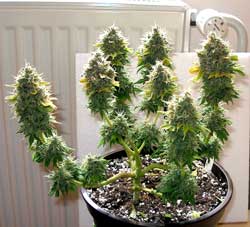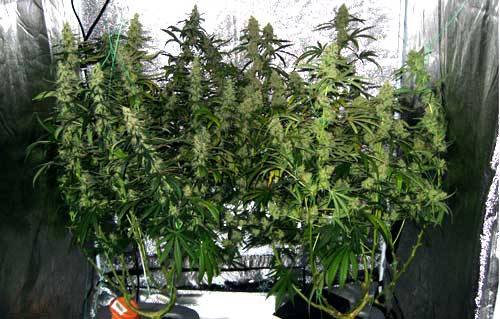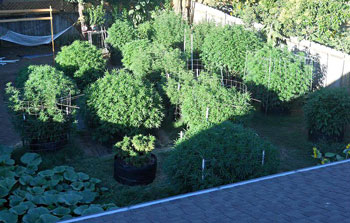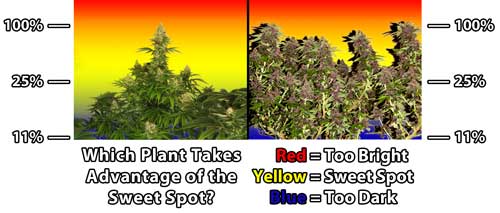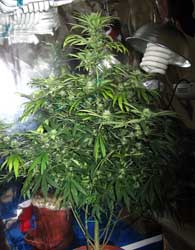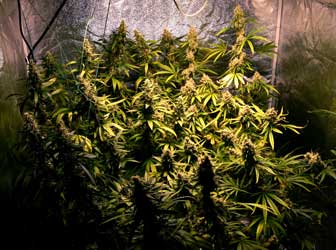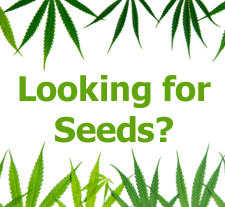You are hereMarijuana Growth Control Methods
Marijuana Growth Control Methods
FIM Your Way to Multiple Colas!
by Sirius Fourside
FIMing: The act of pinching or cutting a young cannabis plant in such a way as to force it to grow 4 main colas instead of one. FIM is used as a word itself, but is actually an acronym for “F**k, I missed!”
So what exactly is FIMing?
Sour Kush SCROG Pics @ 37 days in Flower
HOW DID OGKUSHOG GROW THESE MAGNIFICENT PLANTS?
LST (Low Stress Training) - How to Grow a Short Sativa or Haze
by Nebula Haze
Use LST to Force Any Marijuana Plant to Grow As Short As You Want
How to ScrOG (Screen of Green) Your Marijuana Plants
by Nebula Haze
For those who might not be familiar, the term "ScrOG" (Screen of Green) refers to a marijuana growing technique that uses a net or wire mesh to control the height of the plant.
If you hear or read growers refer to "SCROGing," "scrogging" or "scroggin" a plant, this is what they are talking about.
Super Cropping Marijuana: Simple Secret to Bigger Yields
by Nebula Haze
Cannabis Training Techniques - LST, Topping & More
by Nebula Haze
Make Marijuana Plants Grow How You Want
Introduction: Why Plant Training?
-
Inverse Square Law of Light (important to indoor growers)
-
Low Stress Training (LST)
-
Supercropping (Extreme LST)
-
Sea of Green (SoG)
-
Screen of Green (ScrOG)
-
Main-Lining (Creating a Manifold)
-
Defoliation (Advanced Only)
Introduction: Why Should Growers Train Cannabis Plants?
Cannabis growers often want cannabis plants to grow into a certain size and shape to produce the best yields.
As a grower, you can control a lot of the final size and shape of your plant by using proper cannabis training and growing techniques, such as topping, FIMing, LST, main-lining, supercropping, defoliation, SoG, ScrOG and more. However, no matter how well you train your plants, some grow patterns are going to be determined by your plant's genes, especially in the flowering stage. You can control the genetics by choosing to start with a great strain, and this page will explain everything else you can do to get your cannabis to grow the way you want, so you get the best yields possible.
Many indoor and outdoor cannabis growers prefer to keep their plants relatively short, growing bushy and wide instead of tall and thin. This helps make sure the plant gets plenty of light - light is like "food" for your plants, and providing the right amount of light will give cannabis plants the energy to grow.
Light is Like "Food" for Cannabis Plants
For outdoor growers, plant training helps with better stealth and yields. The sun is all the light an outdoor cannabis plant needs to survive (as long as it's getting direct light for the majority of the day). But most outdoor growers are looking to make their cannabis grow in a way that produces the most amount of bud for the size of the plant, while keeping plants low profile so they're harder to spot from far away.
Outdoors, a bushy cannabis plant produces the best yields for the height because more of the plant is getting light from the sun at any one time. Outdoor growers also often need to be able to prevent their plants from growing too tall. This is accomplished at least partly with cannabis training methods.
Why do indoor cannabis growers want short plants?
For indoor growers, plants tend to yield more if a lot of the plant is kept just the right distance from the grow lights. This means trying to maintain a flat cannabis canopy under the grow lights and almost always using growth training methods like topping, FIMing, main-lining, ScrOG, etc. These training methods help make sure all the buds get as much light as possible, so you get bigger yields from the same grow lights.
Why do cannabis plants need to be close to the grow lights? It is because indoor grow lights follow the inverse square law of light. The light from indoor grow lights is not like the sun. The sun is so far away that the inverse square law of light doesn't make a difference - your plant will get about the same amount of light whether it's on the ground or 10 feet in the air.
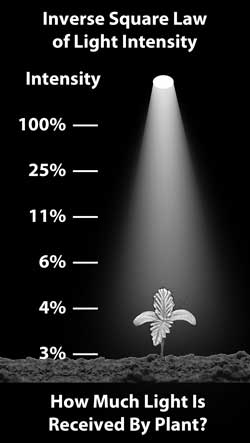 Using indoor grow lights is different from growing under the sun. The further away a plant is from an indoor grow light, the less light the plant will receive. With grow lights, the amount of light received by the plants drops off fast as plants get further away.
Using indoor grow lights is different from growing under the sun. The further away a plant is from an indoor grow light, the less light the plant will receive. With grow lights, the amount of light received by the plants drops off fast as plants get further away.
This is a huge part of why it's important to understand how far away your lights need to be, depending on what type of light you have.
Learn more about cannabis grow lights
Powerful Grow Lights - Some grow lights are very bright and powerful (like MH/HPS grow lights or high-powered LEDs). The more powerful a grow light is, the further it will generally need to be kept from your plants, but in many cases more powerful grow lights will also be able to cover a greater area. Whenever buying MH/HPS grow lights or LEDs, it's important to understand exactly how far away to keep the lights from your plants. With MH/HPS lights, this is easy to know. For LED grow lights, it's important you ask the manufacturer how far away the LEDs should be from your plants. You need to know the "sweet spot" where your cannabis plants are getting just the right amount of light, so you can train your plants to take advantage of it.
Less Powerful Grow Lights - Grow lights like CFLs and fluorescent lights have a "sweet spot" that is only a few inches away. The further you get, the less light your plants get. These types of lights can grow cannabis plants, and may be a good choice for some growers, but with less powerful lights, it becomes even more important that you learn how to train your plants to grow short and wide with many colas. Luckily the methods on this page like topping, FIMing, SoG, ScrOG, main-lining and more will give you the tools you need to get the most from your grow lights. By using plant training techniques, it becomes possible to harvest ounces of bud even from relatively small grow lights.
What distance should your grow lights be from your plants?
Learn what you need to know about grow lights here: http://www.growweedeasy.com/grow-lights
Leaves in the "Sweet Spot" of Your Indoor Grow Light Make the Most Energy, Producing Faster Growth and Bigger Buds
In the above diagram, you can see that the natural plant (left - completely untrained) has less parts of the plant in the best light. As a result, this plant only has one big cola, and the rest of the colas are much smaller.
Why settle with just one big cola when you could have many huge colas?
The trained plant (right - which has been topped and trained with LST) has many colas that are directly in the sweet spot. In fact, almost the whole plant is getting bathed in just the right amount of light from the grow lights. This means the plant has many big colas.
A plant with many colas in the sweet spot will end up yielding more than a plant with just one main cola. So make sure you know what the sweet spot is for your indoor grow lights!
Generally, the top of the grow light sweet spot is where the biggest buds form. Cannabis plants love a lot of light, much more than your average house plant. As long as you stay away from the "too bright" zone for your particular indoor grow lights (which can cause light burn, even if air is cool), you want to get as many colas in the top of the sweet spot as possible.
Colas in the Top of the Sweet Spot Grow Biggest
It doesn't matter what type of grow light you use. Each type of grow light has a sweet spot, and indoor growers can maximize their yields by training the plant so that the majority of the plant and colas are taking advantage of the best light.
Cannabis uses light to grow and make buds. Indoor growers want to make sure that the majority of the plant is bathed in just the right amount of light. This is accomplished with cannabis training techniques like topping, FIMing, LST, supercropping, ScrOG, SoG, main-lining, defoliation and more (all explained below).
Maximize Yields by Training Cannabis Plants For Many Colas Bathing in the Exact Right Amount of Light
Different grow lights need to be kept at different heights from cannabis plants, but in almost all indoor growing setups, there are benefits to training your cannabis plants to grow short and wide. By having more of your plant at the best distance from your grow light, your cannabis leaves will be exposed to more light and give your plant more energy to grow.
When your grow lights are positioned above your cannabis plants....
Plants with a flat canopy will produce more energy than tall & thin plants
|
Don't Grow This Plant! |
Grow a Trained Plant With Dozens of Colas! |
There are a couple of different techniques that you can use to get cannabis to grow more wide & bushy as opposed to growing tall. This will give you the ability to grow lots of fat colas instead of just one.
This page lists some of the most common cannabis training techniques, including information about plant training techniques such as LST, supercropping, main-lining, ScrOG nets, SoG and cutting/pinching techniques like topping and FIMing.
As an indoor cannabis grower, you don't have to just accept the way cannabis grows naturally. You actually have a lot of control over how your cannabis plants grow. So train your plants to efficiently fill up your grow space, giving you the best yields possible with your grow lights.
Learn more about cannabis grow lights: http://www.growweedeasy.com/grow-lights
When growing cannabis indoors or outdoors, it is your responsibility as a cannabis caretaker to ensure that your plants grow the way you want. The following techniques will give you the power to grow a cannabis plant that fits in whatever space you desire.

